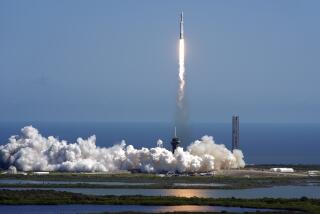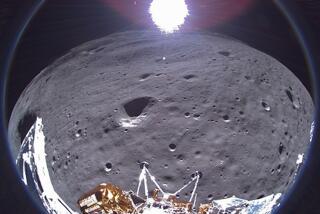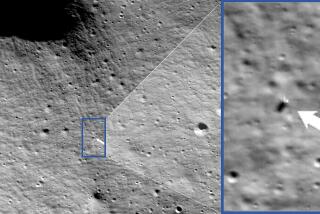It’s official: Rosetta’s long journey with comet 67P has ended

The European Space Agency’s Rosetta orbiter will commit operational suicide early Friday morning, but first it has just a little bit more science to do.
- Share via
The Rosetta mission to catch up with a speeding comet, land a space probe on it and follow it as it flies past the sun has officially come to an end.
Early Friday morning, the European Space Agency’s Rosetta orbiter committed operational suicide when it deliberately smashed onto the surface of 67P/Churyumov-Gerasimenko, the mountain-sized comet that has been its constant companion for the last two years.
The crash was slow but still fatal. The mission’s lander, Philae, was built with legs, springs and harpoons to help it land on a comet and survive. In contrast, the Rosetta orbiter was designed to fly around 67P, not touch down on the surface.
Spacecraft operations manager Sylvain Lodiot confirmed that the orbiter had gone offline at 4:19 a.m. PDT on Friday morning — right on schedule.
“We will be listening for the signal for another 24 hours, but we don’t expect any,” he said from ESA’s control center in Darmstadt, Germany. “This is the end of the Rosetta mission. Thank you and good night.”
There were no cameras to record Rosetta’s final moments, but ESA engineers said the spacecraft probably bounced a few times, given the comet’s low gravity. In the process, it probably kicked up a cloud of dark, dry dust before settling in its final resting place on the smaller of the comet’s two lobes.
“At the moment of impact, Rosetta will be crushed,” flight director Andrea Accomazzo said during the mission’s final hours. “It will remain on the comet forever because there is no way to get it off the surface.”
But this death dive was not made in vain. Mission planners at ESA put Rosetta to work until the last possible second, programming it to collect high-resolution data from closer to the comet’s surface than ever before.
Rosetta was not the first space mission to study a comet, but it was the first to really get to know one. Flying alongside 67P for nearly two years, it was able to observe how the comet evolved and changed as it traveled toward the sun and then retreated to the outer solar system.
“It’s been a tremendously successful mission,” said Paul Weissman, a comet scientist at the Planetary Science Institute in Tucson who worked on Rosetta for 20 years. “Our plan was to rendezvous with the comet far from the sun and then watch its activity grow and die back down, and that’s exactly what happened.”
The 11 instruments on Rosetta were designed to observe many aspects of the comet. They mapped its physical surface features, sniffed the cloud of gas and dust around its nucleus, analyzed its interaction with the solar wind and used radio waves to probe its interior.
Ultimately, scientists hope their study of 67P will reveal clues about the origin of the solar system and the beginning of life on Earth.
Researchers say the comet formed 4.6 billion years ago, at the dawn of the solar system. Because it has spent nearly its entire life in a deep freeze, the frozen molecules trapped in its nucleus could offer hints about the composition of the pre-solar nebula from which the sun and all the planets formed.
In addition, comets like 67P may have brought the molecular building blocks for life to our planet.
Rosetta’s travels with 67P began in August 2014, after a convoluted 10-year journey across 4.9 billion miles of space. At the time of their first encounter, the 2.5-mile-long comet was still in the cold regions of the solar system, 335 million miles from the sun. (To put that in context, the Earth is about 93 million miles from the sun; Jupiter, on average, is 483.8 million miles away.)
Rosetta sent the Philae lander down to the comet’s nucleus in November 2014, making it the first probe to touch a comet and live to tell about it. It famously bounced twice before beaming three days’ worth of data back to scientists on Earth.
In the meantime, Rosetta continued to accompany 67P as it flew closer to the sun. Under the orbiter’s watchful eye, the comet grew increasingly more active as the warmth of the sun caused frozen ices in the nucleus to sublimate and turn into gas jets that came shooting off the comet’s surface.
ESA scientists report that when the orbiter first approached the comet, it was releasing about 300 grams of water vapor per second, the equivalent of two small glasses of water. By the time the comet reached perihelion, its closest approach to the sun, it was spewing up to 300 kilograms of water vapor — enough to fill two bathtubs — every second.
During this active period, Rosetta had to keep a safe distance of at least 200 miles away so that the outbursts of gas and dust would not interfere with its navigational instruments.
The comet has become much less active as it flies away from the sun and out toward the orbit of Jupiter.
In the last few weeks, Rosetta’s massive solar panels have been unable to get enough sunlight to power all its instruments at once. Mission engineers knew it wouldn’t be long before Rosetta would lose its ability to function.
ESA officials insist that although the operations part of the mission has come to an end, the Rosetta science has only just begun. There are tens of thousands of observations to comb through, log and make available to researchers around the world. And scientists say they have only barely started to understand how to fit all the pieces of the puzzle together.
“If you are in high school now, you could go to university and work on Rosetta data as a science researcher,” said Matt Taylor, Rosetta’s project scientist. “There is enough to go around.”
Do you love science? I do! Follow me @DeborahNetburn and “like” Los Angeles Times Science & Health on Facebook.
MORE IN SCIENCE
The Rosetta orbiter is about to commit suicide, but first, a bit more science
Eye-tracking technology shows that preschool teachers have implicit bias against black boys
An unusual ‘black moon’ is coming Friday, but it’s not the end of the world
UPDATES:
9:30 a.m.: Updated with spacecraft’s landing.
4:30 a.m.: Updated with spacecraft’s descent completed.
This story was originally posted at 2:30 a.m.







